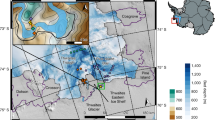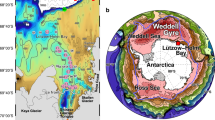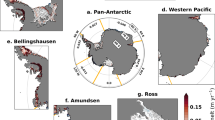Abstract
Ice–ocean interactions at the bases of Antarctic ice shelves are rarely observed, yet have a profound influence on ice sheet evolution and stability. Ice sheet models are highly sensitive to assumed ice shelf basal melt rates; however, there are few direct observations of basal melting or the oceanographic processes that drive it, and consequently our understanding of these interactions remains limited. Here we use in situ observations from the Ross Ice Shelf to examine the oceanographic processes that drive basal ablation of the world’s largest ice shelf. We show that basal melt rates beneath a thin and structurally important part of the shelf are an order of magnitude higher than the shelf-wide average. This melting is strongly influenced by a seasonal inflow of solar-heated surface water from the adjacent Ross Sea Polynya that downwells into the ice shelf cavity, nearly tripling basal melt rates during summer. Melting driven by this frequently overlooked process is expected to increase with predicted surface warming. We infer that solar heat absorbed in ice-front polynyas can make an important contribution to the present-day mass balance of ice shelves, and potentially impact their future stability.
This is a preview of subscription content, access via your institution
Access options
Access Nature and 54 other Nature Portfolio journals
Get Nature+, our best-value online-access subscription
$29.99 / 30 days
cancel any time
Subscribe to this journal
Receive 12 print issues and online access
$259.00 per year
only $21.58 per issue
Buy this article
- Purchase on Springer Link
- Instant access to full article PDF
Prices may be subject to local taxes which are calculated during checkout



Similar content being viewed by others
Data availability
Data for coastlines and ice shelves in Figs. 2 and 3 are from the Antarctic Digital Database (https://www.add.scar.org/). The RIS frontal line was modified to reflect recent changes in frontal position. MODIS images in Figs. 1a and 3c were sourced from the NSIDC Images of Antarctic Ice Shelves archive (http://nsidc.org/data/iceshelves_images/index_modis.html). SST data are from the GHRSST Multi-scale Ultra-high Resolution (MUR) SST record, obtained from the NASA EOSDIS Physical Oceanography Distributed Active Archive Center at the Jet Propulsion Laboratory (https://doi.org/10.5067/GHGMR-4FJ01). Sea-ice concentration data are from the NOAA/NSIDC Climate Data Record of Passive Microwave Sea Ice Concentration, Version 3 (https://doi.org/10.7265/N59P2ZTG). Offshore CTD data are from the Calibrated Hydrographic Data from the Ross Sea acquired with a CTD during the RV Nathaniel B. Palmer expedition NBP1101 (2011) dataset (https://doi.org/10.1594/IEDA/317595), downloaded from http://www.marine-geo.org/tools/search/Files.php?data_set_uid=17595. Mooring data are archived at https://figshare.com/s/1c92fe8eb227b878e344. ApRES radar data are archived at https://figshare.com/s/1255b7d76ed69e015c3a.
Code availability
Computer code used to process the radar observations is available from the corresponding author on request.
References
Rignot, E., Jacobs, S., Mouginot, J. & Scheuchl, B. Ice-shelf melting around Antarctica. Science 341, 266–270 (2013).
Depoorter, M. et al. Calving fluxes and basal melt rates of Antarctic ice shelves. Nature 502, 89–92 (2013).
Arthern, R. J. & Williams, C. R. The sensitivity of West Antarctica to the submarine melting feedback. Geophys. Res. Lett. 44, 2352–2359 (2017).
Reese, R., Gudmundsson, G. H., Levermann, A. & Winkelmann, R. The far reach of ice-shelf thinning in Antarctica. Nat. Clim. Change 8, 53–57 (2018).
Pattyn, F. Sea-level response to melting of Antarctic ice shelves on multi-centennial timescales with the fast Elementary Thermomechanical Ice Sheet model (f.ETIShv1.0). Cryosphere 11, 1851–1878 (2017).
Jenkins, A., Nicholls, K. W. & Corr, H. F. J. Observation and parameterization of ablation at the base of Ronne Ice Shelf, Antarctica. J. Phys. Oceanogr. 40, 2298–2312 (2010).
Jacobs, S., Hellmer, H., Doake, C., Jenkins, A. & Frolich, R. Melting of ice shelves and the mass balance of Antarctica. J. Glaciol. 38, 375–387 (1992).
Orsi, A. H. & Wiederwohl, C. L. A recount of Ross Sea waters. Deep Sea Res. Pt II 56, 778–795 (2009).
Jenkins, A. et al. Observations beneath Pine Island Glacier in West Antarctica and implications for its retreat. Nat. Geosci. 3, 468–472 (2010).
Paolo, F. S., Fricker, H. A. & Padman, L. Volume loss from Antarctic ice shelves is accelerating. Science 348, 327–331 (2015).
Velicogna, I., Sutterley, T. & Van Den Broeke, M. Regional acceleration in ice mass loss from Greenland and Antarctica using GRACE time-variable gravity data. Geophys. Res. Lett. 41, 8130–8137 (2014).
Shepherd, A. et al. Mass balance of the Antarctic ice sheet from 1992 to 2017. Nature 556, 219–222 (2018).
Shepherd, A. et al. Recent loss of floating ice and the consequent sea level contribution. Geophys. Res. Lett. 37, L13503 (2010).
Pritchard, H. et al. Antarctic ice-sheet loss driven by basal melting of ice shelves. Nature 484, 502–505 (2012).
Jacobs, S. S., Amos, A. F. & Bruchhausen, P. M. Ross Sea oceanography and Antarctic Bottom Water formation. Deep Sea Res. Oceanogr. Abstr. 17, 935–962 (1970).
Nicholls, K. W., Østerhus, S., Makinson, K., Gammelsrød, T. & Fahrbach, E. Ice-ocean processes over the continental shelf of the southern Weddell Sea, Antarctica: a review. Rev. Geophys. 47, RG3003 (2009).
Sverdrup, H. U. The currents off the coast of Queen Maud Land. Norsk Geogr. Tidssk. 14, 239–249 (1954).
Zhou, Q. et al. Wind-driven spreading of fresh surface water beneath ice shelves in the Eastern Weddell Sea. J. Geophys. Res. Oceans 119, 3818–3833 (2014).
Gammelsrod, T. & Slotsvik, N. Hydrographic and current measurements in the southern Weddell Sea 1979/80. Polarforschung 51, 101–111 (1981).
Jenkins, A. & Doake, C. S. M. Ice-ocean interaction on Ronne Ice Shelf, Antarctica. J. Geophys. Res. 96, 791–813 (1991).
Makinson, K. & Nicholls, K. W. Modeling tidal currents beneath Filchner-Ronne Ice Shelf and on the adjacent continental shelf: their effect on mixing and transport. J. Geophys. Res. Oceans 104, 13449–13465 (1999).
Hattermann, T., Nøst, O. A., Lilly, J. M. & Smedsrud, L. H. Two years of oceanic observations below the Fimbul Ice Shelf, Antarctica. Geophys. Res. Lett. 39, L12605 (2012).
Stern, A. A., Dinniman, M. S., Zagorodnov, V., Tyler, S. W. & Holland, D. M. Intrusion of warm surface water beneath the McMurdo Ice Shelf, Antarctica. J. Geophys. Res. Oceans 118, 7036–7048 (2013).
Moholdt, G., Padman, L. & Fricker, H. A. Basal mass budget of Ross and Filchner-Ronne ice shelves, Antarctica, derived from Lagrangian analysis of ICESat altimetry. J. Geophys. Res. Earth 119, 2361–2380 (2014).
Crary, A., Robinson, E., Bennett, H. & Boyd, W. Glaciological regime of the Ross Ice Shelf. J. Geophys. 67, 2791–2807 (1962).
Neal, C. The dynamics of the Ross Ice Shelf revealed by radio echo-sounding. J. Glaciol. 24, 295–307 (1979).
Bamber, J. & Bentley, C. A comparison of satellite-altimetry and ice-thickness measurements of the Ross Ice Shelf, Antarctica. Ann. Glaciol. 20, 357–364 (1994).
Assmann, K., Hellmer, H. H. & Beckmann, A. Seasonal variation in circulation and water mass distribution on the Ross Sea continental shelf. Antarct. Sci. 15, 3–11 (2003).
Holland, D. M., Jacobs, S. S. & Jenkins, A. Modelling the ocean circulation beneath the Ross Ice Shelf. Antarct. Sci. 15, 13–23 (2003).
Dinniman, M. S., Klinck, J. M. & Smith, W. O. Influence of sea ice cover and icebergs on circulation and water mass formation in a numerical circulation model of the Ross Sea, Antarctica. J. Geophys. Res. 112, C11013 (2007).
Arzeno, I. B. et al. Ocean variability contributing to basal melt rate near the ice front of Ross Ice Shelf, Antarctica. J. Geophys. Res. Oceans 119, 4214–4233 (2014).
Brennan, P. V., Nicholls, K., Lok, L. B. & Corr, H. Phase-sensitive FMCW radar system for high-precision Antarctic ice shelf profile monitoring. IET Radar Sonar Navig. 8, 776–786 (2014).
Nicholls, K. W. et al. A ground-based radar for measuring vertical strain rates and time-varying basal melt rates in ice sheets and shelves. J. Glaciol. 61, 1079–1087 (2015).
Horgan, H. J., Walker, R. T., Anandakrishnan, S. & Alley, R. B. Surface elevation changes at the front of the Ross Ice Shelf: implications for basal melting. J. Geophys. Res. 116, C02005 (2011).
Griggs, J. & Bamber, J. Antarctic ice-shelf thickness from satellite radar altimetry. J. Glaciol. 57, 485–498 (2011).
GHRSST Level 4 MUR Global Foundation Sea Surface Temperature Analysis v.2 (JPL MUR MEaSUREs Project, accessed 8 July 2018); https://doi.org/10.5067/GHGMR-4FJ01
Kohut, J. Calibrated Hydrographic Data from the Ross Sea Acquired with a CTD During the Nathaniel B. Palmer Expedition NBP1101 (MGDS, accessed 27 August 2011); https://doi.org/10.1594/ieda/317595
Gade, H. G. Melting of ice in sea water: a primitive model with application to the Antarctic ice shelf and icebergs. J. Phys. Oceanogr. 9, 189–198 (1979).
Gilmour, A. E. Ross Ice Shelf sea temperatures. Science 203, 438–439 (1979).
Årthun, M., Holland, P. R., Nicholls, K. W. & Feltham, D. L. Eddy-driven exchange between the open ocean and a sub–ice shelf cavity. J. Phys. Oceanogr. 43, 2372–2387 (2013).
Jendersie, S., Williams, M. J., Langhorne, P. J. & Robertson, R. The density-driven winter intensification of the Ross Sea circulation. J. Geophys. Res. Oceans 123, 7702–7724 (2018).
Meier, W. et al. NOAA/NSIDC Climate Data Record of Passive Microwave Sea Ice Concentration v.3 (NOAA/NSIDC, accessed 7 March 2019); https://doi.org/10.7265/N59P2ZTG
Ohshima, K. I., Nihashi, S. & Iwamoto, K. Global view of sea-ice production in polynyas and its linkage to dense/bottom water formation. Geosci. Lett. 3, 1–14 (2016).
Smethie, W. M. Jr. & Jacobs, S. S. Circulation and melting under the Ross Ice Shelf: estimates from evolving CFC, salinity and temperature fields in the Ross Sea. Deep Sea Res. Pt I 52, 959–978 (2005).
Renfrew, I. A., King, J. C. & Markus, T. Coastal polynyas in the southern Weddell Sea: variability of the surface energy budget. J. Geophys. Res. Oceans 107(C6), 16-1–16-22 (2002).
Jacobs, S. S. & Comiso, J. C. Sea ice and oceanic processes on the Ross Sea continental shelf. J. Geophys. Res. Oceans 94, 18195–18211 (1989).
Bromwich, D. H., Carrasco, J. F., Liu, Z. & Tzeng, R.-Y. Hemispheric atmospheric variations and oceanographic impacts associated with katabatic surges across the Ross Ice Shelf, Antarctica. J. Geophys. Res. Atmos. 98, 13045–13062 (1993).
Comiso, J. C., Kwok, R., Martin, S. & Gordon, A. L. Variability and trends in sea ice extent and ice production in the Ross Sea. J. Geophys. Res. 116, C04021 (2011).
Smith, W. O., Dinniman, M. S., Hofmann, E. E. & Klinck, J. M. The effects of changing winds and temperatures on the oceanography of the Ross Sea in the 21st century. Geophys. Res. Lett. 41, 1624–1631 (2014).
Dinniman, M. S., Klinck, J. M., Hofmann, E. E. & Smith, W. O. Effects of projected changes in wind, atmospheric temperature, and freshwater inflow on the Ross Sea. J. Climate 31, 1619–1635 (2018).
Jansen, D., Luckman, A., Kulessa, B., Holland, P. R. & King, E. C. Marine ice formation in a suture zone on the Larsen C Ice Shelf and its influence on ice shelf dynamics. J. Geophys. Res. Earth 118, 1628–1640 (2013).
Doake, C., Corr, H., Rott, H., Skvarca, P. & Young, N. Breakup and conditions for stability of the northern Larsen Ice Shelf, Antarctica. Nature 391, 778–780 (1998).
Fürst, J. J. et al. The safety band of Antarctic ice shelves. Nat. Clim. Change 6, 479–482 (2016).
Scambos, T., Bohlander, J. & Raup, B. Images of Antarctic Ice Shelves, Version 1: West Ross Ice Shelf (National Snow and Ice Data Center, 1996); https://doi.org/10.7265/N5NC5Z4N
Jacobs, S. S., Fairbanks, R. G. & Horibe, Y. Origin and Evolution of Water Masses Near the Antarctic Continental Margin: Evidence from \(H_2^{18}O/H_2^{16}O\) Ratios in Seawater 59–85 (American Geophysical Union, 1985).
Peng, G., Meier, W. N., Scott, D. J. & Savoie, M. H. A long-term and reproducible passive microwave sea ice concentration data record for climate studies and monitoring. Earth System Sci. Data 5, 311–318 (2013).
Stewart, C. L. Ice-Ocean Interactions Beneath the North-western Ross Ice Shelf, Antarctica. PhD thesis, Univ. Cambridge (2018).
Fujita, S., Matsuoka, T., Ishida, T., Matsuoka, K. & Mae, S. A summary of the complex dielectric permittivity of ice in the megahertz range and its applications for radar sounding of polar ice sheets. Phys. Ice Core Records http://hdl.handle.net/2115/32469 (2000).
Reeh, N. On the calving of ice from floating glaciers and ice shelves. J. Glaciol. 7, 215–232 (1968).
Jenkins, A., Corr, H. F., Nicholls, K. W., Stewart, C. L. & Doake, C. S. Interactions between ice and ocean observed with phase-sensitive radar near an Antarctic ice-shelf grounding line. J. Glaciol. 52, 325–346 (2006).
Thomson, R. E. & Emery, W. J. Data Analysis Methods in Physical Oceanography 3rd edn (Newnes, 2014).
Hengl, T., Heuvelink, G. B. & Rossiter, D. G. About regression-kriging: from equations to case studies. Comput. Geosci. 33, 1301–1315 (2007).
Hansen, T. M. mGstat: a geostatistical Matlab toolbox (2004); https://sourceforge.net/projects/mgstat/
Holland, D. M. & Jenkins, A. Modeling thermodynamic ice-ocean interactions at the base of an ice shelf. J. Phys. Oceanogr. 29, 1787–1800 (1999).
Boyer, T. P. et al. World Ocean Database 2013 (NODC, accessed 3 June 2016); https://www.nodc.noaa.gov/
Acknowledgements
The authors acknowledge T. Arnold, B. Grant and R. Benson for assistance with the radar survey fieldwork, and Antarctica New Zealand, the Andrill programme and the Woods Hole Oceanographic Institute for field support, hot-water drilling at the mooring site and assistance with the mooring deployment, respectively. We thank J. Kohut for the use of CTD data gathered by during the RV Nathaniel B. Palmer Ross Sea Expedition 2011 funded by NSF grant no. ANT08-39039, and thank C. Stevens for comments that improved the manuscript. C.L.S. was supported by the Rutherford Foundation and Antarctica New Zealand through the Scott Centenary Scholarship.
Author information
Authors and Affiliations
Contributions
C.L.S. and M.J. M.W. designed and deployed the sub-ice shelf mooring. C.L.S. designed the radar survey, and C.L.S. and P.C. undertook the radar fieldwork. C.L.S. analysed the radar data with advice from K.W.N. All authors contributed to the manuscript.
Corresponding author
Ethics declarations
Competing interests
The authors declare no competing interests.
Additional information
Publisher’s note: Springer Nature remains neutral with regard to jurisdictional claims in published maps and institutional affiliations.
Supplementary information
Supplementary Information
Supplementary figures and tables.
Rights and permissions
About this article
Cite this article
Stewart, C.L., Christoffersen, P., Nicholls, K.W. et al. Basal melting of Ross Ice Shelf from solar heat absorption in an ice-front polynya. Nat. Geosci. 12, 435–440 (2019). https://doi.org/10.1038/s41561-019-0356-0
Received:
Accepted:
Published:
Issue Date:
DOI: https://doi.org/10.1038/s41561-019-0356-0
This article is cited by
-
West Antarctic ice volume variability paced by obliquity until 400,000 years ago
Nature Geoscience (2023)
-
The morphological changes of basal channels based on multi-source remote sensing data at the Pine Island Ice Shelf
Acta Oceanologica Sinica (2023)
-
A Semi-Empirical Framework for ice sheet response analysis under Oceanic forcing in Antarctica and Greenland
Climate Dynamics (2023)
-
Heterogeneous melting near the Thwaites Glacier grounding line
Nature (2023)
-
Seasonal variability of ocean circulation near the Dotson Ice Shelf, Antarctica
Nature Communications (2022)



